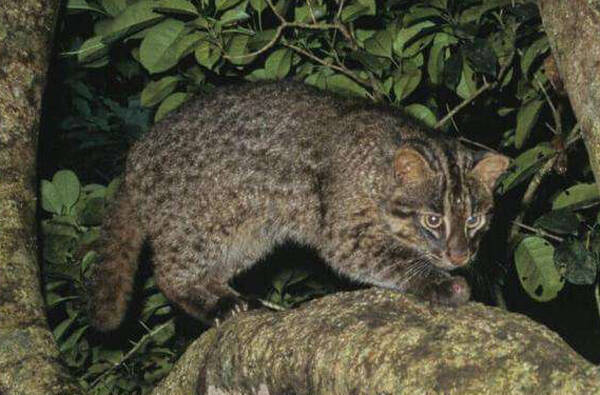Felis iriomotensis(P.b.iriomotensis
IUCN
LCBasic Information
Scientific classification
- name:Felis iriomotensis(P.b.iriomotensis
- Scientific Name:Felis iriomotensis(P.b.iriomotensis,Iriomote cat
- Outline:Carnivora
- Family:Schizopoda Felinae Ocelot
Vital signs
- length:50-60cm
- Weight:3-5kg
- lifetime:8-13years
Feature
The cat's paw is bigger than that of an average cat, and its tail is also very thick.
Distribution and Habitat
It is only distributed in Iriomote Island in the Yaeyama Islands of the Ryukyu Islands, and is easier to find in mountain wetlands and rivers.
Appearance
The body length is 50-60 cm, the tail length is 23-24 cm, and the weight is 3-5 kg. The body shape retains primitive characteristics, slightly fatter than ordinary cats, with a very long trunk and thick and short limbs. The back and sides of the body are dark brown, the abdomen is lighter, and there are inconspicuous dark spots scattered on the gray-brown part of the sides. The paw is larger than that of ordinary cats, and the tail is also very thick, with some tufts of hair at the tip, making it look thicker in appearance. The nose bridge is very large, and there are white and black stripes around the eyes. The ears are very round, and there is no premolar hair in the ear shell at the tip. The back of the ear has a black edge and white stripes called "tiger ear book spots" like many mountain cats. There are 28 teeth, one pair less upper jaw premolars than ordinary cats.
Details
The Iriomote cat, scientific name Felis iriomotensis (P.b.iriomotensis), is a subspecies endemic to Okinawa, Japan. In the local dialect, the Iriomote cat is called "Yamamaya" (cat in the mountains), "Pingumaaya" (cat that escaped) and "Yamapicalaya", which shows that the Iriomote cat is not a wild cat that has evolved from a domestic cat to a wild cat.

In March 1965, after Okinawa returned to the jurisdiction of the Japanese government, animal writer Yukio Togawa collected skull and fur specimens of the Iriomote cat and conducted related research. In 1967, wild individuals (one male and one female cat) were captured. In 1967, Yoshinori Imaizumi, director of the National Museum of Nature and Science, named the Iriomote cat as a new species and published it at a conference. At that time, the last discovery of a new species of wild cat was 70 years ago, so this was regarded as the greatest discovery in biology in the 20th century. The area of Iriomote Island is only about 290 square kilometers, which is also the smallest island in the world where cats exist.
The Iriomote cat is a nocturnal animal. Except for the breeding season, it will act in pairs, and usually lives alone. It mainly lives in low-altitude areas along the coast, and likes wetlands and riverbanks. It usually lives on the ground, but can climb trees and swim.
The food sources of the Iriomote cat are wide, and they prey on birds, rodents, lizards, snakes, frogs, shrimps, small river crabs, insects, etc. Sometimes they also catch young wild boars, and they also have the habit of diving to catch prey. In addition to meat, the captive Iriomote cat "ケイ太" also eats tender grass every day. Most cats can quickly and reliably kill their prey by inserting their fangs into the spinal cord of their prey, but it is not certain whether the Iriomote cat can do the same. There are no natural enemies on the island. It is the only carnivorous mammal and is at the top of the island's food chain.
It is generally believed that the lifespan of the Iriomote cat in captivity is 8-9 years, and even shorter in the wild. In 1979, a male kitten "Keita" about five weeks old was separated from his parents and sent to the Okinawa Children's National Zoo Aquarium for breeding. He eventually died of old age, having lived for a total of 13 years.
It is an endangered species---its wild population faces a high probability of extinction in the near future.
Protect wild animals and eliminate game.
Maintaining ecological balance is everyone's responsibility!








